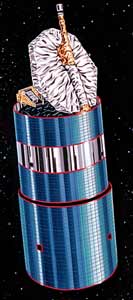Thank you very much for visiting Gunter's Space Page. I hope that this site is useful and informative for you.
If you appreciate the information provided on this site, please consider supporting my work by making a simple and secure donation via PayPal. Please help to run the website and keep everything free of charge. Thank you very much.
MEASAT 1, 2 / Africasat 1, 2

MEASAT 1
[Boeing BSS]
Binariang Sdn. Bhd. of Kuala Lumpur took a major step toward enhancing Malaysia's infrastructure and regional communications by signing a contract with Hughes Space and Communications International, Inc. (HSCI), on 17 May 1994. The agreement concluded more than two years of discussion following a memorandum of understanding signed in November 1991, and ended an international competition that HSCI won over three competitors. The contract called for delivery of one Hughes HS-376 model spacecraft and an option for a second, forming the Malaysia-East Asia Satellite (MEASAT) system. Binariang exercised its option on Nov. 30, 1994, and authorized Hughes to proceed with a second 376 satellite.
The MEASAT system will provide the first direct-to-user (DTU) service in Malaysia, as well as general communications services in an area reaching from India to Hawaii and from Japan to East Australia. Among DTU services are television and educational programs beamed to small (50-cm) home antennas. General regional communications services include telephony, television, data transmission, and business networks. Binariang is the first cellular operator in Malaysia to offer fully digital services.
Both MEASAT spacecraft were built by Hughes Space and Communications Company (HSC) in El Segundo, California. The first satellite was launched aboard an Ariane-44L H10-3 rocket on Jan. 12, 1996, from Kourou, French Guiana. Launch of the second satellite was Nov. 13, 1996, also on an Ariane-44L H10-3. HSC also supplied equipment for a satellite control station on Malaysia's Langkawi Island and trained Malaysian spacecraft controllers.
The MEASAT HS-376 models feature three important performance bonuses compared to standard versions. First, each delivers 40 percent more payload power--more than 1200 Watts--by employing gallium arsenide solar cells rather than silicon. MEASAT 1 was the first commercial communications satellite to use gallium arsenide solar cells. Second, HSC's lightweight, high-gain shaped antenna made its HS-376 debut on MEASAT. The antenna's specially contoured dual surfaces and single aperture eliminate the need for multiple feedhorns. Third, MEASAT uses a bipropellant propulsion system instead of a monopropellant for greater stationkeeping and attitude control efficiency. MEASAT 1 is contracted to operate for 12 years; MEASAT 2 has an 11-year lifetime.
After separation from the rocket, a Thiokol Star-30 solid apogee motor lifts the spacecraft from transfer orbit to geosynchronous orbit. One nickel-hydrogen battery supplies power during eclipses.
MEASAT 1 has five high-power Ku-band transponders, plus one spare, for DTU service. These use 112 watt traveling-wave tube amplifiers. In addition, 12 C-band transponders perform regional service, powered by 12 watt solid-state amplifiers, with an additional three spare transponders. MEASAT 2 has eight 95 watt and three 62 watt Ku-band transponders, as well as six 12 watt C-band (72 MHz) transponders, including spares.
Uplink for the C-band regional beam is 5.9 to 6.4 GHz, while downlink is 3.7 to 4.2 GHz on both spacecraft. C-band effective isotropic radiated power (EIRP) averages 39 dBW. The Ku-band on MEASAT 1 uses 13.25 to 14.5 GHz uplink and 10.95 to 12.4 GHz downlink. On MEASAT 2, the uplink is 13.7 to 14.4 GHz and downlink is 10.95 to 12.62 GHz. The Ku-band EIRP ranges from 56 to 59 dBW on MEASAT 1. The range is 55.6 to 59 dBW on MEASAT 2. Both C-band and Ku-band use orthogonal linear polarization.
MEASAT 1 was relocated to 46° E and renamed Africasat 1 in January 2008. In early 2010 MEASAT 2 was renamed Africasat 2.
Africasat 2 was maneuvered off station in July 2018, likely to be retired.
| Nation: | Malaysia |
|---|---|
| Type / Application: | Communication |
| Operator: | Binariang Sdn. Bhd. → MEASAT Satellite Systems Sdn. Bhd. |
| Contractors: | Hughes |
| Equipment: | 5 (+1) high-power Ku-band transponders (#1), 11 Ku-band transponders (#2), 12 C-band transponders (both) |
| Configuration: | HS-376 |
| Propulsion: | Star-30 |
| Power: | Solar cells (body mounted and drop-skirt), batteries |
| Lifetime: | 12 years (#1); 11 years (#2) |
| Mass: | 1450 kg (886 kg BOL) |
| Orbit: | GEO |
| Satellite | COSPAR | Date | LS | Launch Vehicle | Remarks | |
|---|---|---|---|---|---|---|
| MEASAT 1 → Africasat 1 | 1996-002B | 12.01.1996 | Ko ELA-2 | Ariane-44L H10-3 | with PAS 3R | |
| MEASAT 2 → Africasat 2 | 1996-063B | 13.11.1996 | Ko ELA-2 | Ariane-44L H10-3 | with Arabsat 2B |
References:
- Boeing: MEASAT 1, 2
Further Africasat missions:
|
